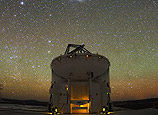
 |
| (Photo/Xinhua) |
WASHINGTON, Nov. 9 (Xinhua) -- U.S. space agency NASA on Friday renamed a recently launched mission that studies Earth's radiation belts as the Van Allen Probes in honor of the late physicist James Van Allen, who discovered the radiation belts encircling Earth in 1958.
The new name of the mission, previously called the Radiation Belt Storm Probes (RBSP), was announced Friday during a ceremony at the Johns Hopkins University based in Baltimore, the U.S. state of Maryland.
"James Van Allen was a true pioneer in astrophysics," said John Grunsfeld, astronaut and associate administrator for NASA's Science Mission Directorate at the agency's headquarters in Washington, D.C. "His ground breaking research paved the way for current and future space exploration. These spacecraft now not only honor his iconic name but his mark on science."
During his career, Van Allen was the principal investigator for scientific investigations on 24 Earth satellites and planetary missions, beginning with the first successful American satellite, Explorer I, and continuing with Pioneer 10 and Pioneer 11.
Launched Aug. 30 from Cape Canaveral Air Force Station in Florida, the Van Allen Probes comprise the first dual-spacecraft mission specifically created to investigate the radiation belts that surround Earth. These two belts encircle the planet and are filled with highly charged particles.
The belts are affected by solar storms and coronal mass ejections and sometimes swell dramatically. When this occurs, they can pose dangers to communications, GPS satellites and human spaceflight activities.














 First alpine rail gets midnight maintenance
First alpine rail gets midnight maintenance


![]()
